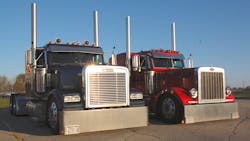There’s been enormous bottom-line pressure applied to small- to medium-sized trucking companies — those operating anywhere from three on up to 150 trucks — in recent years. Yet that pressure may be set to ease significantly in 2017 if capacity cuts and a proposed “regulatory rollback” occur as expected.
“They are actually in a pretty good position now,” Dan Pedowitz, vice president of LTL for third party logistics (3PL) and freight brokerage firm AFN, told Fleet Owner.
“If they’ve been investing in technology and preparing to adopt ELDs (electronic logging devices), the pendulum is going to start swinging back in their favor,” he said.
From a broader freight market perspective, John Larkin, managing director and head of transportation capital markets research for Stifel Capital Markets, noted in a recent brief that the elimination of capacity from several sectors of the freight transportation industry in response to weak demand starting in the second half of 2015 through 2016 – with railroads and TL carriers in particular reducing system capacity in order to maintain equipment utilization and boost returns on investment – should trigger an improvement in freight rates starting as early as the second quarter this year and no later than the second quarter of 2018.
“Pricing should begin to recover sometime in 2017,” he explained. “With demand potentially improving and supply declining, the prospects for a reversal in the negative pricing trends that dominated the second half of 2015 and 2016 should reverse.”Larkin added that the Trump administration’s “particular focus” on reducing the regulatory burdens that, in its view, serves as an “impediment” to economic growth could benefit smaller carriers as well.
“This is a double-edged sword as regulations have been so complex that only big [transportation] companies can comply with [such] technically-challenging rules, much to the chagrin of smaller carriers, which typically do not have the staff or the expertise to deal with them,” he said.
“So, smaller carriers may breathe a sigh of relief thanks to this broad initiative to roll back, soften, or eliminate existing regulations and to reduce the number of additional regulations to be layered on top of an already debilitating collection [of rules],” Larkin pointed out.
“While the survival of small carriers may increase competition across the trucking industry, large carriers should be able to offset some of the effects of the increased competition through increased asset utilization,” he emphasized.
AFN’s Pedowitz noted, however, that when it comes to competition, smaller carriers bring innate advantages to the table that many shippers might begin to favor.
“From a shipper perspective, a smaller guy say with 25 to 50 trucks is going to be probably be putting the same drivers on specific lanes to haul their freight,” he said. “So dock personnel are going to see the same people every time and that will help develop a rapport that leads to a better understanding of specific operational needs on both sides.”
Steve Sashihara, founder and CEO of Princeton Consultants, also noted that the fragmented nature of the trucking industry – especially the long-haul sector – could benefit smaller carriers as well.
“Long-haul trucking is the opposite of most of the large mature industries that we’re familiar with, where a few big players dominate the market and little guys scramble around to pick up the small pieces,” he said in a conference call last week. “Think banking, think airlines, and think railroading. Now think trucking; the brand name giants are actually a very, very small part of commercial trucking, fractions of 10%.”
About the Author
Sean Kilcarr
Editor in Chief
Sean Kilcarr is a former longtime FleetOwner senior editor who wrote for the publication from 2000 to 2018. He served as editor-in-chief from 2017 to 2018.

